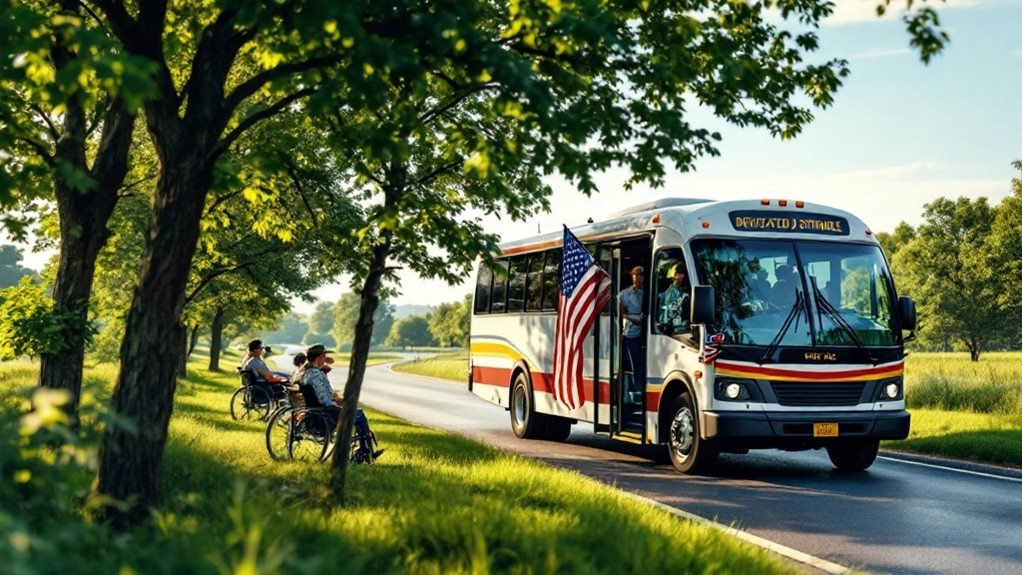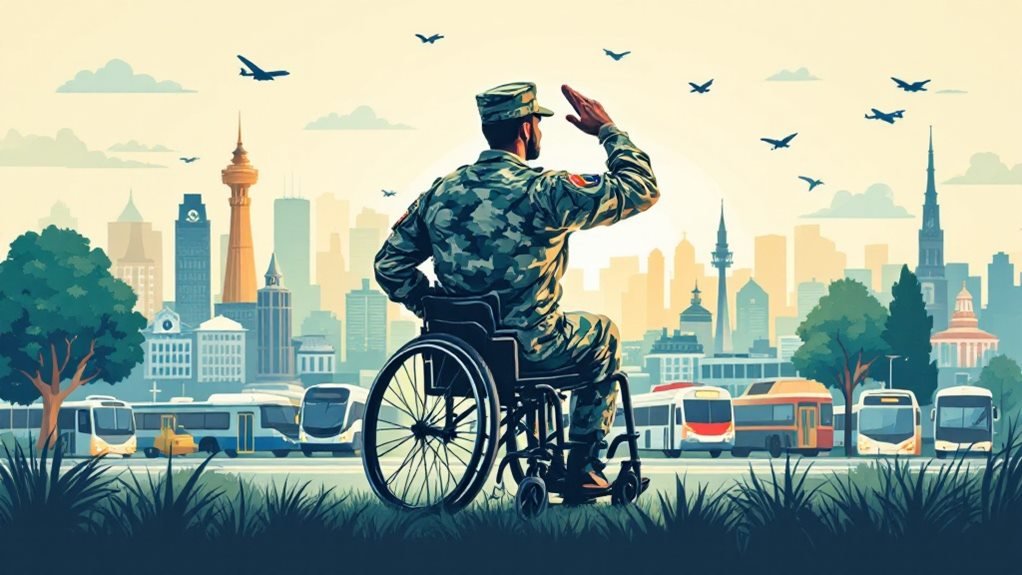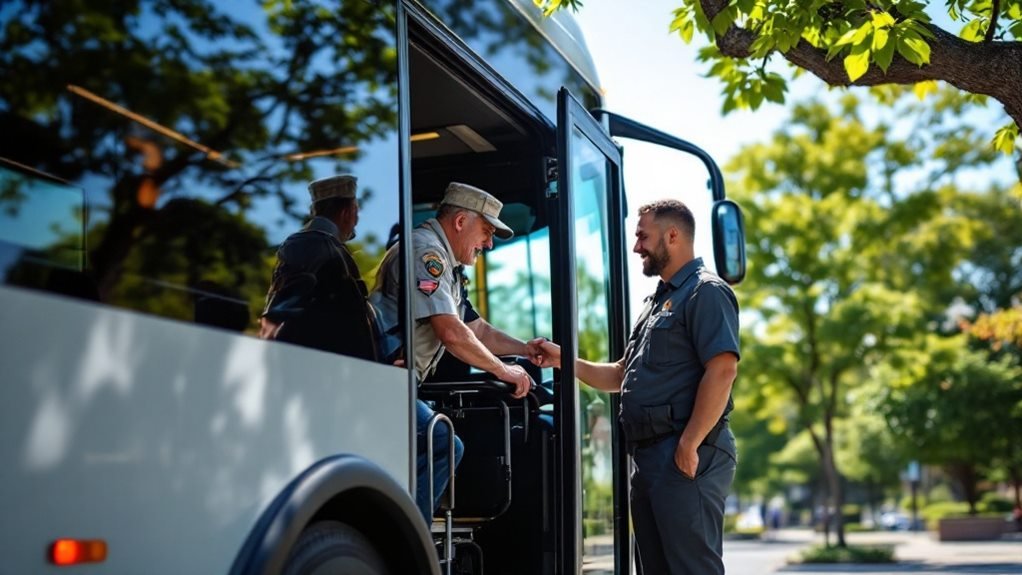Yes, veterans can be transported, and there are diverse options available to meet their needs. We can utilize the Veterans Transportation Service, supportive non-profits, and public transit systems that offer veteran-specific programs. Many ride-sharing companies provide discounts and priority booking for veterans, increasing their destination access. Challenges like social isolation and mobility issues exist, but initiatives such as adaptive vehicles and mobility aid integration address these concerns. Government programs and innovative solutions further support veterans' transportation needs. As we explore available resources, we'll discover how these services promote independence and connectivity for our veterans.
Key Takeaways
- Veterans can access transportation through the Veterans Transportation Service (VTS) for medical appointments and social activities.
- Ride-sharing companies offer discounted rides and prioritize bookings specifically for veterans.
- Local non-profit organizations provide volunteer-based transportation services tailored for veterans' needs.
- Public transit systems offer veterans-specific programs, including discounted fares and specialized routes.
- Disabled veterans can use adaptive vehicles with wheelchair lifts and hand controls for increased mobility.
Current Transportation Options
When it comes to guaranteeing that veterans have access to transportation, there are several options available that cater to their unique needs. As a community, we recognize the importance of veteran mobility and the role it plays in their well-being.
One prominent solution is the Veterans Transportation Service (VTS), which offers safe and reliable transport to medical appointments. The VTS operates with a keen awareness of transport logistics, guaranteeing that schedules align with veterans' healthcare needs.
Additionally, local non-profit organizations often step in to provide tailored transportation services. These groups, staffed by volunteers committed to serving others, help bridge gaps in mobility by offering rides to essential services and community events. Our collective effort to support these initiatives can directly impact a veteran's quality of life.
Public transit systems in some areas have also adapted to include veterans-specific programs. Discounted fares and specialized routes guarantee that veterans can navigate their communities with ease.
Furthermore, ride-sharing companies have formed partnerships to offer veterans discounted rides, enhancing their access to a broader range of destinations.
Challenges Faced by Veterans
Maneuvering the transportation landscape can be an intimidating task for many veterans, as they face a unique set of challenges that hinder their mobility. Mental health concerns, such as PTSD or anxiety, can make even the thought of traveling overwhelming. These challenges often lead to social isolation, as veterans may feel disconnected from their communities.
Financial burdens further complicate matters, with limited resources available for transportation costs, adding stress to their already challenging circumstances. Mobility issues, whether due to physical injuries or aging, demand special accommodations that aren't always readily available.
Veterans utilizing service animals for support face additional transportation logistics, as not all modes of transport are equipped to accommodate their needs. This can hinder their ability to travel independently.
Community integration becomes difficult without reliable transportation, leaving veterans struggling to attend medical appointments, social events, or job interviews. For those relying on caregivers, the challenges multiply, as coordination of schedules and accessibility can become overwhelming.
It's essential for us to understand these barriers and work towards solutions that enhance their quality of life. By fostering empathy and action, we can support veterans in overcoming these obstacles, ensuring they remain connected and active in their communities.
Transportation for Disabled Veterans
Often, transportation for disabled veterans requires tailored solutions to meet their specific needs and secure their independence. As we endeavor to serve those who've served us, it's essential to understand how adaptive vehicles and mobility aids can play a transformative role in their lives.
These customized modes of transportation not only provide freedom but also enhance their quality of life. Adaptive vehicles are designed to accommodate various disabilities. They might include wheelchair lifts, hand controls, and other modifications that allow disabled veterans to drive themselves.
For those unable to drive, these vehicles guarantee safe and comfortable travel with the help of a caregiver or driver. Mobility aids, such as motorized scooters or walkers, can be seamlessly integrated into these vehicles, making it easier for veterans to commence their journeys without hassle.
Our responsibility is to secure these heroes have access to the resources they need, advocating for funding and support that make adaptive vehicles and mobility aids accessible. By doing so, we help eliminate barriers and empower them to lead fulfilling, independent lives.
Together, we can make a tangible difference in the way veterans navigate their world.
Access to Medical Appointments
As we explore how veterans can access essential medical appointments, it's vital to understand the transportation assistance programs available to them.
These programs are designed to support veterans with various needs, but eligibility criteria can sometimes be complex.
Transportation Assistance Programs
Steering access to medical appointments can be a substantial challenge for veterans, especially those facing mobility issues or living in rural areas.
Transportation barriers often compound the logistical challenges veterans encounter when trying to reach essential health services. These obstacles can seem overwhelming, but thankfully, there are transportation assistance programs designed to bridge this vital gap.
By understanding and utilizing these programs, we can help guarantee that veterans receive the care they deserve. The Department of Veterans Affairs (VA) offers several initiatives aimed at providing reliable transportation options.
For instance, the Veterans Transportation Service (VTS) and the Beneficiary Travel program play key roles in supporting veterans' access to medical facilities. These programs focus on minimizing transportation barriers by offering rides or reimbursement for travel costs related to medical appointments.
Local communities and non-profit organizations also contribute notably. Many groups offer volunteer-based transportation services, confirming that veterans aren't left isolated due to their location or physical abilities.
Eligibility Criteria Explained
Understanding the eligibility criteria for transportation assistance is fundamental in guaranteeing veterans can access the medical appointments they need. As we navigate these requirements, it's important to recognize the diverse veteran demographics we serve. Veterans come from varied backgrounds, each with specific needs and circumstances. By understanding these nuances, we can tailor our support to make sure no one is left behind.
The eligibility requirements for transportation often hinge on several factors, such as service-connected disabilities, income levels, or geographic location. For instance, veterans with a disability rating may qualify for more extensive support, while those experiencing financial hardship might be eligible for assistance based on income thresholds.
Additionally, rural veterans can face unique challenges, making access to reliable transportation even more critical.
It's essential to familiarize ourselves with these criteria so we can effectively advocate for veterans in our community. By doing so, we not only help streamline their access to necessary medical care but also honor their service by removing barriers to health and wellbeing.
Let's commit to spreading awareness about these eligibility requirements and work together to guarantee every veteran receives the support they deserve.
Government Programs and Initiatives
When it comes to ensuring our veterans have access to necessary transportation, government programs like Veterans Transportation Services and Federal Travel Assistance Programs play a crucial role.
These initiatives are designed to alleviate the burden of travel costs and logistical challenges, enabling veterans to reach medical appointments and other essential destinations.
Veterans Transportation Services
Maneuvering transportation options can be a significant challenge for many veterans, but thankfully, government programs and initiatives are stepping up to address these needs.
As we endeavor to enhance veteran mobility and transportation accessibility, it's essential to explore how Veterans Transportation Services are making a difference. These services offer a critical lifeline, ensuring veterans can access necessary medical appointments, employment opportunities, and social engagements, all of which are fundamental for a fulfilling life post-service.
The Department of Veterans Affairs (VA) has implemented several initiatives aimed at improving transportation options. For instance, the Veterans Transportation Program (VTP) offers a variety of solutions tailored to meet diverse needs.
It includes the Highly Rural Transportation Grants, which provide funding to organizations assisting veterans in remote areas, ensuring no one is left behind due to geographic limitations.
Additionally, the Veterans Transportation Service (VTS) provides free rides to medical appointments, reducing the burden on veterans who might otherwise struggle with logistics or costs.
By focusing on both urban and rural veterans, these services aim to bridge gaps and foster a more inclusive environment.
Together, we can support veterans' journeys toward greater independence and well-being.
Federal Travel Assistance Programs
While Veterans Transportation Services provide essential support, it's equally important to reflect on the broader spectrum of federal travel assistance programs available to veterans.
These programs are vital, offering aid that guarantees veterans can access medical care, attend important events, and reconnect with loved ones. By leveraging federal funding, these initiatives address travel logistics that might otherwise pose insurmountable challenges for our veterans.
One of the key programs is the Veterans Transportation Program (VTP), which offers grants to organizations that help veterans get to medical appointments.
This program showcases how federal funding can be effectively utilized to ease travel logistics. Additionally, the Beneficiary Travel Program reimburses veterans for travel expenses incurred while accessing VA healthcare.
This means veterans don't have to worry about the financial burden of reaching necessary medical services.
We must also highlight the importance of the Veterans Airlift Command, a private initiative supported by federal grants, which provides free air transportation for medical and compassionate purposes.
Nonprofit Organizations' Role
Nonprofit organizations play an indispensable role in guaranteeing veterans have access to transportation for medical appointments, employment opportunities, and social engagements. They bridge gaps left by federal programs, offering tailored support through community involvement and dedicated volunteer drivers.
By engaging local communities, these organizations harness the power of collective goodwill, turning concern into action. We see countless individuals and groups stepping up to provide veterans with reliable and compassionate transportation services.
Volunteer drivers are the backbone of these initiatives. They offer their time and vehicles to guarantee veterans reach their destinations safely. These volunteers often go beyond simply providing a ride; they foster connections and demonstrate genuine care, creating a supportive environment for veterans.
This personal touch can make a significant difference in a veteran's day-to-day life, reducing isolation and promoting well-being.
Moreover, nonprofits often collaborate with local businesses and civic groups to secure funding and resources, guaranteeing the sustainability of their programs. They remain committed to identifying and addressing the unique transportation needs of veterans, continually adapting to serve them better.
Together, we can make a lasting impact by supporting and participating in these crucial community efforts.
Innovative Transportation Solutions
In recent years, we've witnessed a surge of innovative transportation solutions that are transforming how veterans access essential services. By focusing on smart mobility, we can address the unique challenges veterans face in reaching medical appointments, employment opportunities, and community events.
Smart mobility leverages data-driven approaches to streamline veteran logistics, guaranteeing timely and efficient transportation solutions tailored to individual needs.
One promising initiative involves partnerships between public transit operators and veteran organizations to design routes and schedules that align with veterans' requirements. This collaboration guarantees that veterans can access specialized care and other resources without the stress of unreliable transportation.
Additionally, rideshare programs specifically for veterans are emerging, offering flexible and cost-effective alternatives that respect their schedules and commitments.
We can also explore the potential of volunteer driver programs, where community members can contribute directly by providing transportation. These programs foster a sense of camaraderie and support, reinforcing the community's commitment to honoring those who've served our country.
Technology in Veteran Transportation
As we explore innovative solutions for veterans' transportation needs, technology plays a pivotal role in enhancing their mobility options.
It's vital that we leverage the power of modern advancements to guarantee our veterans can access the services and opportunities they deserve. Mobile applications can connect veterans with transportation services at the touch of a button. These apps offer real-time updates, route optimization, and scheduling flexibility, making it easier for veterans to plan their journeys seamlessly.
By incorporating features like voice commands and simplified interfaces, these applications can be made accessible for those with varying needs.
Autonomous vehicles present another groundbreaking opportunity. As these vehicles become more advanced, they promise to offer a level of independence previously unimaginable.
Imagine veterans who face mobility challenges having the ability to travel without relying on others' schedules. Autonomous vehicles can provide safe, reliable, and convenient transportation, potentially reducing the stress and limitations faced by veterans in rural or underserved areas.
Community-Based Support Systems
Many communities have established robust support systems to guarantee veterans can access the transportation they need. We recognize that community engagement is vital in developing these systems, as it fosters a network of support that makes sure no veteran is left behind.
Local organizations, veteran networks, and volunteers work together to provide reliable transportation options, often customizing services to meet the unique needs of veterans in their area.
By participating in community engagement initiatives, we guarantee that these systems are both sustainable and adaptable. For instance, some communities have developed ride-sharing programs where volunteers use their personal vehicles to transport veterans to medical appointments, job interviews, or community events.
These programs not only provide essential services but also strengthen the bonds between veterans and their communities.
Moreover, veteran networks play a pivotal role in identifying transportation needs and advocating for solutions. By sharing experiences and resources, these networks help us address gaps in service and create more thorough support systems.
Through collaboration and a shared commitment to service, we can make a tangible difference in the lives of veterans, ensuring they've the mobility and access they deserve. Together, we can build a community where every veteran feels supported and valued.
Future Developments and Trends
Anticipating future developments in veteran transportation, we focus on leveraging technology and innovation to enhance accessibility and efficiency.
As we look ahead, the integration of autonomous vehicles could revolutionize how veterans travel. By reducing the need for a human driver, autonomous vehicles promise a more flexible and reliable transportation option for veterans, especially those with mobility challenges.
Imagine a world where scheduling a ride isn't dependent on driver availability, but rather on the readiness of a fleet of self-driving cars.
In tandem, ride-sharing services are evolving to better serve our veteran community. By collaborating with organizations dedicated to veterans' needs, these services can offer tailored solutions, such as prioritized booking and cost-effective travel options.
As we explore these possibilities, we remain committed to understanding the unique requirements of veterans, ensuring that every journey is safe, respectful, and dignified.
Our mission is to harness these advancements to create a transport system that not only meets the practical needs of veterans but also enriches their quality of life.
Together, we can build a future where transportation isn't a barrier but a bridge to independence and opportunity.
Conclusion
As we navigate the intricate paths of veteran transportation, we're all travelers on the same journey, working to bridge the gaps that separate our heroes from the care and opportunities they deserve. We've explored the current roads and faced the challenges together, discovering the power of technology and community support. By embracing innovative solutions and government initiatives, we're paving the way for a future where every veteran can reach their destination with dignity and ease.



